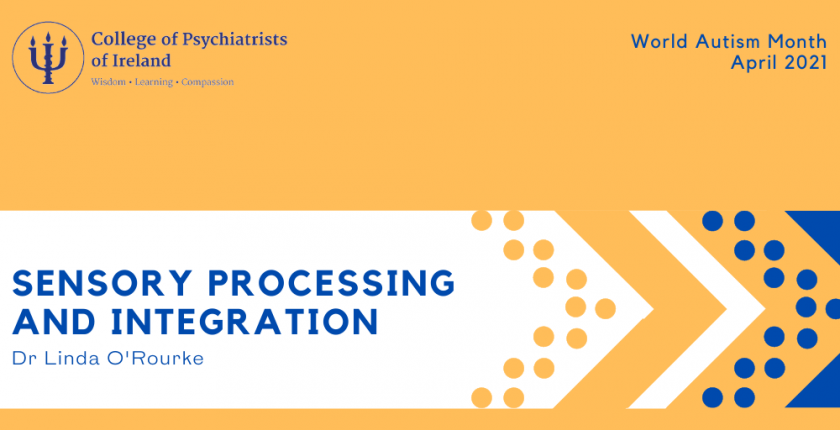Blog
World Autism Month: Sensory Processing and Integration
- April 29, 2021
- Category: Blog External Affairs & Policy Public Information Stakeholders

Dr Linda O’Rourke writes about sensory processing for World Autism Month, including what it looks like when it works well, what it’s like for people who experience sensory processing difficulties and what psychiatrists can do to help patients who have difficulties processing sensory information.
Sensory processing is the process by which our bodies receive, interpret, organise and act on information from the world around us. We use it to make sense of ourselves and our environment. It is a neurological process that occurs naturally within our brain requiring little conscious effort or attention. Information is inputted, the brain sorts this information and sends commands to our autonomic or motor systems. We use our senses to input information into our sensory processing system; our seven senses which overlap and integrate with each other.
The Seven Senses are Touch (tactile), Hearing (auditory), Sight (visual), Smell (olfactory), Taste (gustatory), Movement (vestibular) – maintains balance and body tone, e.g. sitting upright and Spatial awareness (proprioceptive) – awareness of body position without looking at body part.
When our sensory processing system works well, it helps us to increase attention and concentration, reduce anxiety, increase comfort with our environment, improve our internal motivation, communicate clearly and improve our performance in tasks. However, occasionally individuals experience sensory processing difficulties such as being overly sensitive to sensory stimuli, under sensitive or struggling to modulate sensory input, which impact on daily functioning.

Consider our sense of touch (tactile processing). We use this to protect ourselves; it allows our body to automatically withdraw or defend itself from unwanted, harmful or painful stimuli. It also allows us to discriminate within our environment. For example, touch tells our brain the precise size, shape and texture of an object in the environment, we know what an object is simply by touching it. An overly sensitive tactile system can cause difficulties…’I feel everything light touch, deep touch, hard or soft, sharp or dull, vibration, temperature and they hurt….if a child says their socks hurt or the label on their T-shirt is itchy, it may seem strange to those who are under-sensitive. If we never notice the feel of our clothing, it seems strange that a tag can cause intense discomfort.
As adults, we could perhaps consider our desk in work and think about visual processing. Some people have super neat desks, others messy, some have lots of coloured post-its, others arrange items by size, some face the window, and others would be too distracted by all that is happening outside. Similarly, we all differ in our levels of auditory processing. Our auditory processing system allows us to associate and decode sounds, to discriminate between sounds and to build a memory of sounds we have heard before. However, it also does more, it tells us the shopping centre is too loud, headphones soothe and comfort or when the radio is playing I can concentrate better on the report I need to write.
But what happens when our sensory processing system does not work well? Robertson et al (2013) demonstrated a highly significant positive correlation between autistic traits and sensory processing difficulties in the general population. McCormick et al (2016) noted sensory symptoms in 69%-93% of autistic individuals and we all know that the DSM 5 included sensory processing differences in their current diagnostic criteria for autism, ‘hyper or hypo reactivity to sensory input or unusual interests in sensory aspects of the environment’. Sensory difficulties can be caused by deficits in input (reduced registration), processing (interpretation difficulties), output (reduced organisation and execution of a response) and emotion response (emotional dysregulation). Neurotypical thresholds enable up to 90% of sensory input to be processed subconsciously. However, thresholds of autistic individuals are believed to be set lower, significantly lower, such that over 90% of sensory information may have to be processed consciously.
When so much sensory modulation needs to be done ‘online’, it is exhausting and prone to flaws. It can lead to:
- difficulty interpreting and responding correctly to sensory information
- over-responding, under-response or variable unpredictable responses to sensory information
Some features of Sensory Modulation Difficulties

So if a patient is experiencing sensory processing difficulties, what can we as Psychiatrists do?
- Be aware of sensory processing difficulties
- Consider it when physical or mental illness does not explain distress or behaviour
- Be vigilant to a person’s environment for triggers to sensory sensitivities
- Take a history and/or ask the patient to complete a sensory screening tool (lots of questionnaires online)
- Ask your team Occupational Therapist if they or a colleague are trained in sensory assessments and if they would suggest sensory integration therapy for this patient.
